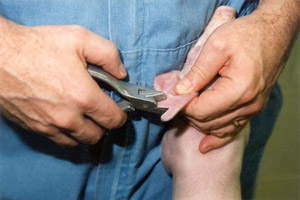G1880
Proper Way to Ear Notch Pigs
This publication is designed to serve as a guide in notching pigs and for reference in conducting a training session at a 4-H club meeting.
Scott E. Brady, Extension Educator
Duane E. Reese, Extension Swine Specialist
One basic task involved in the 4-H Swine Project that continually challenges many 4-H members, leaders and parents is properly ear notching project pigs. While for some this is a matter-of-fact task, others have great difficulty understanding the purpose or practice of notching.
Use this guide as a reference for conducting training sessions.
Ear notching provides:
- A permanent, inexpensive identification system, and
- Individual identity for all animals
Universal Ear-notching System
Ear-notching helps identify a pig’s litter and which one of the litter it is, giving each pig a unique identity number. Notches are placed in one of five locations in the pig’s right ear — to show the litter number — and in one of three locations in the left ear — to show the individual pig number. “Reading” the notches allows producers, judges, and other swine professionals to know more about the pig they’re viewing.
Correctly notching the pig is key. Each pig must be notched differently. So, to notch pigs properly, you must know the location and associated number of each notch.
The most common ear-notching system is shown in Figure 1.
The right ear has five locations for notches, and each location is assigned a number. Those five numbers are 1, 3, 81, 9, or 27. Look at Figure 1 to find each notch location. Except for the 81 notch, one or two notches may be at each of the other four locations.
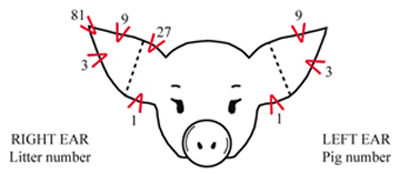 |
| Figure 1. Universal ear notching system |
To determine the litter number for a pig, add the numerical values assigned to each notch, as shown in Figure 2.
| Litter No. = 1+1+81+9 = 92 | 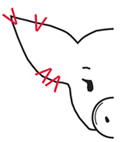 |
Litter No. = 1+3+3+27 = 34 |
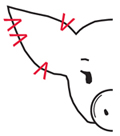 |
|
| Figure 2. Examples for litter numbers 92 and 34. | ||||
The left ear has three locations for notches, and each location is assigned a number. Those three numbers are 1, 3 and 9. Look at Figure 1 to find each notch location. As with litter numbers, the number values are added. (Figure 3).
The litter number is notched in the pig’s right ear and the individual pig number in the pig’s left ear.
| Pig No. = 1+1+3+9 = 14 | 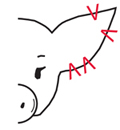 |
Pig No. = 1+3+3 = 7 | 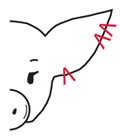 |
|
Figure 3. Examples for pig numbers 14 and 7. |
||||
Combining Both Ears
After a pig is notched in its right and left ear, it has a unique identity. Examples are shown in Figure 4.
 |
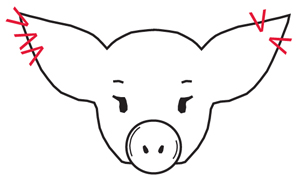 |
|
Litter No. 1+1+9+27 = 38 (pig’s right ear) This pig’s identity is 38-4. |
Litter No. 3+3+81 = 87 This pig’s identity is 87-12. |
|
| Figure 4. Examples of properly notched pigs. | ||
Techniques to Ensure Effective Notching
Avoid placing a notch midway in the outside edge of either ear (that is, close to the dotted line indicated in Figure 1). Such marks can easily be mistaken for either a 1 or a 3 or a 9 or a 27.
Remember, the reference to left and right ear refers to the pig’s left or right ear, as viewed from the rear of the pig. Left and right does not refer the viewers’ left or right in a situation where the pig is facing the viewer.
|
If pigs are notched at 1-3 days of age, the task is much easier. If you allow pigs to become large (100 lb), the task is considerably more demanding mentally and physically.
Use a V-ear notcher to notch piglets weighing less than about 25 pounds. These notchers typically make a notch that is 3/16 to 1/4 inch deep (Figure 5). For larger pigs, a notcher that makes notches 1/2 inch deep is recommended.
It is important to have some disinfectant available to dip the notchers in after each use. In some cases, spraying larger pigs with a wound dressing can be helpful.
Avoid making notches too shallow, as they may become hard to read or possibly heal shut. A notch that is too deep, especially one toward the ear tip, may result in a torn ear.
Leave at least 1/4 inch between notches to ensure easy reading. Do not make notches too close to the tip of the ear, as these can be torn off. When making the #27 notch, uncurl the ear with your fingers so you can make it deep into the cartilage. Otherwise, it might be unreadable later.
If notching ears on older or larger pigs, it may be necessary to house them in separate pens until the notches heal. Pen mates not notched may be attracted to the bloody notches and start ear biting.
When combining ear notching with other pig processing, consider doing the notching last, as it tends to cause more bleeding than other procedures, such as teeth clipping, naval care, injections or tail docking.
This publication has been peer reviewed.
Visit the University of Nebraska–Lincoln Extension Publications Web site for more publications.
Index: Swine
Swine Management
Issued September 2008
